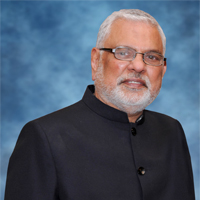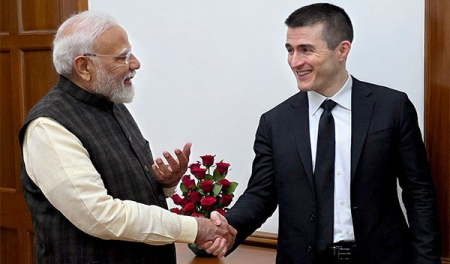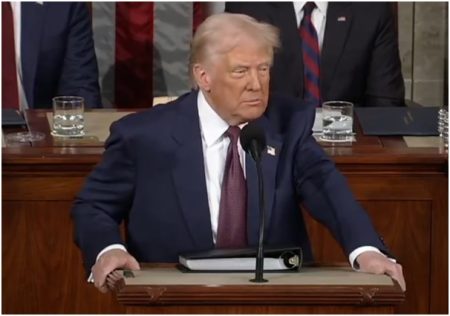Prime Minister Narendra Modi, in his commitment to the people of India for an unprecedented third term, is not just targeting another electoral win but envisioning a transformative leap towards making India a developed nation by 2047. This ambition, articulated through the Bharatiya Janata Party’s (BJP) manifesto for the 2024 Lok Sabha elections, promises a future where the previous terms serve merely as a prelude to an era of “unprecedented development.”
The BJP’s ‘Sankalp Patra’ emerges not as a mere political document but as a blueprint for India’s journey over the next two decades. Modi’s confident rhetoric in a recent interview with the Hindustan Times underlines this vision. He attributes his past terms’ achievements to correcting historical oversights and initiating a rapid growth trajectory. Now, with a sure win for the third term, Modi plans to accelerate this momentum across various sectors, emphasizing the upliftment of the poor, youth, farmers, women, and the middle class through the GYANM model.
The strategy to project a long-term vision reflects an astute political acumen. By anchoring his campaign in India’s future development, Modi effectively shifts the electorate’s focus from the immediate past and present challenges to a hopeful and prosperous future. Furthermore, his emphasis on the routine nature of the delimitation exercise seeks to normalize and depoliticize what could be a contentious issue, thereby reinforcing his leadership as stable and forward-thinking.
As India prepares for the 2024 elections, Modi’s narrative portrays the BJP not only as a party vying for power, but also as a steward steering the country towards a significant milestone in national development. We remain to see whether this vision will resonate with the electorate, given the grand promise and high stakes involved.
Let me now talk about cricket, the Indian people’s second religion.
As the drumbeat of cricket’s fervent following echoes louder in the suburbs of New York, the upcoming T20 World Cup in Eisenhower Park symbolizes a pivotal moment in U.S. sports culture. This June, cricket enthusiasts and novices alike will converge on a newly constructed stadium in suburban New York, which holds the promise of cricket’s expansion in America.
The venue choice of New York is strategic, tapping into the area’s rich cricketing veins nourished by South Asian and Caribbean communities. Local leagues have long thrived here, and with the World Cup, the sport stands on the precipice of mainstream recognition—much like soccer in 1994, after its FIFA World Cup stint in the U.S.
This historic event is not just about sports; it’s a testament to the evolving American cultural tapestry. Cricket, traditionally seen as an outsider in the mainstream American sports lineup, is now setting the stage for a grand showcase. The anticipation is palpable among the players and fans, and the involvement of figures like Usain Bolt underscores the event’s significance.
Local cricket bodies and international organizers see this tournament as a gateway to elevating cricket to a major U.S. sport. Initiatives such as Major League Cricket are gaining momentum, and cricket’s inclusion in the 2028 Olympics is laying the groundwork for sustained growth.
Furthermore, the T20 format, known for its fast-paced and viewer-friendly matches, is perfectly suited to capture the American audience’s imagination. We expect the Pakistan vs. India match, in particular, to draw significant viewership, highlighting the sport’s global appeal.
In summary, the T20 World Cup in New York is more than just a series of cricket matches; it represents a transformative moment for the sport in the U.S. As cricket pitches its tent on American soil, it brings with it a legacy of diversity and competition, promising a thrilling experience for all.
Let me finally discuss Bollywood news, which is combined with news about Indian politics..
Kangana Ranaut’s journey from the quaint hills of Himachal Pradesh to the limelight of Bollywood and now onto the political stage epitomizes a saga of relentless determination and influential change. Known for her fierce independence and refusal to conform to the entrenched norms of the film industry, Kangana has not only won acclaim for her acting prowess but has also become a polarizing figure in the public domain.
Her entry into politics marks a significant pivot in her career, intertwining her cinematic persona with her real-life role as a spokeswoman for cultural and nationalistic values. This transition seems like a natural progression for someone who has consistently used her platform to voice her opinions on a range of social and national issues, often inviting both admiration and controversy.
Kangana’s advocacy for a meritocratic approach in Bollywood has sparked crucial conversations around nepotism and the barriers faced by outsiders. She now seeks to extend her influence beyond cinema by stepping into the political arena, aiming to directly impact governance and public policy. Whether as an actor or a politician, Kangana continues to be a figure of empowerment and change, challenging societal norms and advocating for a more inclusive and fair landscape.
As Kangana Ranaut charts this new course, her journey will undoubtedly be one to watch as it unfolds against the backdrop of India’s dynamic socio-political canvas. The intertwining of her film and political careers showcases not just a personal evolution but also reflects the changing contours of celebrity influence in India.

Raj Shah
Editor-in-Chief










